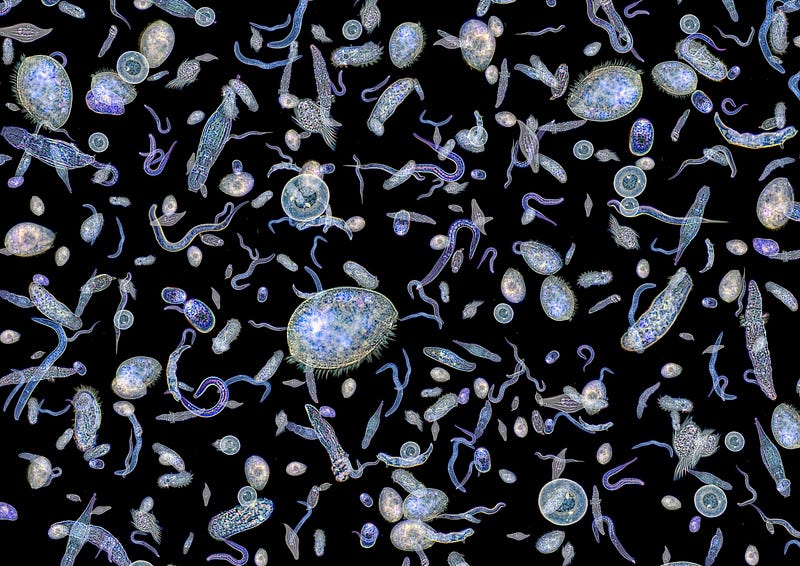Engulfing cells: The origin of multicellular life
By Ryan Brady, Chemical Engineering & Biochemistry, 2022

Humans represent the pinnacle of organized life, with trillions of cells working together to enable complex thought and interaction with the environment. Both of these processes require a great deal of organization and energy production. On a cellular level these attributes can be traced back to the same change which led to the evolution of all multicellular life on Earth. This change was the evolution of simple prokaryotic cells into complex eukaryotic cells. Prokaryotic cells are generally just a single membrane with DNA (lacking a nuclear membrane) and proteins inside, whereas eukaryotes have internal organelles and DNA contained within a nucleus. Although this change occurred almost 2 billion years ago, most scientists agree that the change was caused by the infolding of membranes and the mutualistic engulfment of smaller cells to form organelles. This theory has since been named the endosymbiotic theory.
The earliest life on Earth fell into two categories: archaea and bacteria — two types of single-celled life. A series of changes occurred that led to the advent of multicellular life. One of the first changes was the adaptation of phagocytosis, which is the ability to engulf and consume other cells for nutrients. The ability to consume other cells placed foreign matter into the intracellular space allowing for the rapid accumulation of nutrients. The competitive advantage this provided allowed for its proliferation and provided an avenue for which endosymbiosis could occur.
The word endosymbiosis literally means a symbiotic relationship with one organism living inside of another. Because of the prevalence of phagocytosis in early cellular life, it became common for organisms to find themselves inside of each other. Two theories exist that detail the possible order of events that early cellular evolution occurred. The first states that the intake of prokaryotic cells, which eventually became the mitochondria, served as the keystone event that propagated the immense reorganization of cells’ inner structures and led to the development of eukaryotic cells. The concept is that the cell’s ability to produce energy through a more efficient process led to the development of secondary organelles from internal membranes such as the nucleus and the Golgi bodies — eventually resulting in the eukaryotic cell structure that exists today. The alternative theory is that the development of early eukaryotic cells occurred alongside the symbiotic intake of prokaryotic cells for usage as mitochondria. The key distinction between these two theories is that the first theory posits that the development of mitochondria was the keystone evolutionary event which led to the development of eukaryotic life. On the other hand, the second points to a variety of contributing developments happening simultaneously, such as the development of the nuclear envelope and the formation of chromosomes. Because of how long ago these changes occurred, it is impossible to deduce the exact order of events that led to the formation of eukaryotic life. However, significant evidence supporting the existence of an endosymbiotic event has been uncovered.
Humans represent the pinnacle of organized life, with trillions of cells working together, requiring a great deal of organization and energy production.
The evidence that supports the endosymbiotic theory is mainly derived from the biochemistry of modern mitochondria. The smoking gun that led to the postulation of the theory is the presence of a discrete set of DNA located in mitochondria. This set of DNA contains 27 unique protein-coding genes that are not found in the nuclear DNA and code for proteins that are only expressed in the mitochondria. The organism with the most similar DNA to the mitochondria is a genus of bacteria called Rickettsia, which are a group of parasitic bacteria. Their genomes are significantly larger than that of the mitochondria. This relative size difference has been characterized by genetic reduction the mitochondria underwent because of their integration into eukaryotic cells. Another piece of evidence is the conservation of the ATP synthesis process between many prokaryotes (such as members of Rickettsia) and the methods of production used within the mitochondria.
While mitochondria were the first organelles that evolved through endosymbiosis, they are most likely not alone. It is generally accepted that chloroplasts developed in a similar manner. Genomic similarity between chloroplasts and cyanobacteria (photosynthetic prokaryotes) provide strong evidence for a relationship between these organisms. Further, some scientists point out that the high energy cost of the creation of the endomembrane system points to an extracellular origin for this structure.
Overall, the endosymbiotic theory provides evidence of the early evolutionary events that led to the development of complex life. The ability to effectively produce energy by this special type of cellular specialization paved the way for the evolutionary proliferation that led to the variation of life seen today.
Journal of Theoretical Biology (2017), DOI: 10.1016/j.jtbi.2017.08.001
Annual Reviews (2013), DOI: 10.1146/annurev-ecolsys-110411–160320
